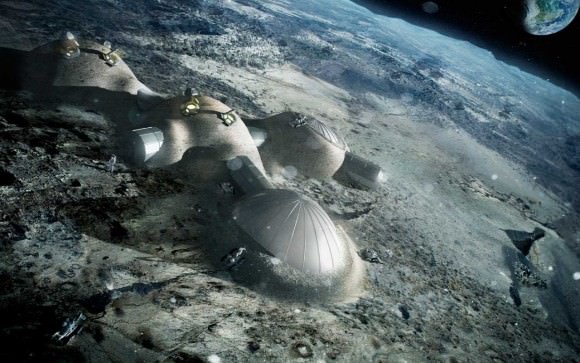Human space exploration is going to kick into high gear in the coming decades. Within the inner Solar System alone, missions are being planned that will see robotic explorers and crews sent to Near Earth Objects (NEOs), back to the Moon, and even on to Mars. Beyond that, there are even plans to send robotic missions to Europa, Enceladus, Titan, and other "ocean worlds" to look for signs of life.
In all cases, questions natural arise as to what kinds of missions will be most suited to them. In the case of places like Titan (which have low gravity and dense atmospheres) aerial drones are considered the best bet. But when it comes to rocky place like asteroids, the Moon and Mars, the best candidate may be robot snakes, which could find their way through tight spaces and travel underground.
This concept was proposed three years ago by the Foundation for Scientific and Industrial Research (SINTEF), the largest independent research organization in Scandinavia. As part of a project commissioned by the ESA - known as SERPEX - they began studying how robots designed to mimic the movements of snakes could assist astronauts aboard the International Space Station.

SINTEF researchers Pål Liljebäck and Aksel Transeth, and Knut Robert Fossum of NTNU's CIRiS, playing with Wheeko the snake robot. Credit: SINTEF/Thor Nielsen.
But as Aksel Transeth, a senior research scientist at SINTEF, explained in a recent press statement, the possibilities go far beyond the ISS:
"More ambitious applications include potential activities on comets and the Moon. [A] Snake Robot that can assist ISS astronauts in maintaining their equipment is perhaps a solution which can be possible to realize on a more short term."
Compared to other robotic explorers, the main selling point of a robot snake is that it offers better mobility. For two decades now, NASA has been exploring the Red Planet with robotic rovers, starting with Pathfinder and Sojourner in 1997, Spirit and Opportunity in 2003, and then Curiosity in 2012. And in a little over two years, they will be sending the Mars 2020 rover.
In all cases, these robots get around on six wheels and conduct experiments using instruments on robotic arms. But as the missions teams behind these rovers have learned, mobility can be a challenge. For instance, after five years on the Martian surface, the Spirit rover became stuck in soft soil, where its mission ended. And as successful as these missions have been at conducting research, there are locations that they simply can't get to.
The SINTEF researchers decided to tackle these issues through biomimicry - i.e. robots that mimic the functions of living creatures. By combining a rover that can navigate over large distances with a snake robot that can crawl along the ground and get into inaccessible places, they believe that future missions would be able to go places and collect samples in ways that other missions could not.

The ESA recently elaborated its plan to create a Moon base by the 2030s. Credit: ESA/Foster+Partners
As Transeth explained back in 2013, this pairing would open up all kinds of possibilities. "We are looking at several alternatives to enable a rover and a robot to work together," he said. "Since the rover has a powerful energy source, it can provide the snake robot with power through a cable extending between the rover and the robot. If the robot had to use its own batteries, it would run out of power and we would lose it."
In the configuration Transeth and his colleagues are envisioning, the rover would handle the task of traveling over long distances and then be able to dispatch the snake to crawl into tight inaccessible areas. They would be connected by a cable that would provide electricity, communication signals and would be used to pull the snake back in. In this sense, the snake would act like one of the rover's arms, but would have the ability to travel autonomously.
"We believe that we can design a robot that can hold on, roll itself up and then extend its body in order to reach new contact points," said Transeth. "Moreover, we believe that it can creep in among equipment components on the ISS and use equipment surfaces to gain traction in order to keep moving forward – much in the same way as real snakes do in the wild."
On Mars, sample collection is crucial to many space agency's research. For the Curiosity rover, the presence of hydrated minerals and clays in soil samples confirmed that Mars once had a warmer, wetter climate. And in the future, scientists hope to find biomakers in Martian soil that could indicate the presence (past or present) of biological life. In this respect, a snake robot would prove very useful since it could access underground recesses the rover cannot.

The sinuous rille known as Rima Ariadaeus, as photographed from Apollo 10, which is the result of a collapsed lava tube. Credit: NASA
On the Moon, snake robots could be especially useful in helping the ESA establish it's proposed "Moon Village" - a permanent base for scientific activity, tourism and mining that would also act as a successor to the ISS. The most likely location for this base could be within stable lava tubes or subterranean tunnels, which would provide natural shielding from meteors, solar radiation and cosmic rays.
But before such construction of this base can take place, these tunnels and lava tubes will have to be inspected to ensure that they are safe for human habitation. The ESA has also been committed to studying comets in recent years, which included sending the Rosetta space probe and Philae lander to rendezvous with the comet 67P/Tsjurjumov–Gerasimenko in 2014.
Unfortunately, the lander experienced problems when its system of harpoons (designed to hold it in place) failed to deploy. As a result, it was forced to make another soft landing which left it in a position and location that was not optimal for research. In the future, the ESA could get avoid this by sending a probe to the surface that would deploy the snakes to the surface, which could then burrow into the comet's interior.
But in the meantime, operations aboard the ISS remain the most realistic and likely application for these robots. Here, astronauts are engaged in ongoing scientific experiments, but are also responsible for maintaining the station and all of its equipment. In this latter respect, the SERPEX project could certainly prove useful, providing them with robot helpers that could help with the regular maintenance.
"It's possible that a robot could carry out some of the routine inspection and maintenance work," said Transeth. "The experiments are stacked in the shelf sections, behind which corrosion can occur. To find this out, inspections have to be made. A snake robot could creep behind the sections, carry out an inspection, and perhaps even perform small maintenance tasks."
Some of the concepts developed by SINTEF so far include the Aiko robot, which was developed to produce a portable system for experimenting with snake robot locomotion. The robot consists of several identical joint modules with two motorized degrees of freedom each. As you can see from the video above, it is propelled by contact forces between the robot and the obstacles in its way.
And then there's the Wheeko robot, which was developed by SINTEF in conjunction with the Center for Interdisciplinary Research in Space (CIRiS), and the Norwegian Space Center (NSC). Much like Aiko, this experimental robot was designed to study snake robot locomotion across flat surfaces. It consists of ten identical joint modules with two motorized degrees of freedom each.
But of course, developing snake robots that can handle various tasks while working in different environments - ranging from working in micro-gravity aboard the ISS to snaking their way through tunnels on a body with gravity - presents many challenges. And in the coming years, Transeth and his colleagues will be looking for ways to address all of them.
"We want to find out what specifications a snake robot system requires," he said. "For example, what kind of sensors does the robot need to obtain an adequate understand its surroundings? What technologies are available to help us meet these needs, and what new technologies will have to be developed? What uncertainties are involved in terms to what it may be possible to achieve?"
Already, astronauts aboard the ISS have robotic helpers in the form of the Synchronized Position Hold Engage and Reorient Experimental Satellite (SPHERES). These free flying satellites serve as test beds for a diverse range of hardware and software, all of which is critical for future space missions that use distributed spacecraft architecture.
Soon enough, they will be replaced by a drone called Astrobee - a robotic cube packed with sensors, cameras, computers, and a propulsion system. The brainchild of the Ames Research Center's Intelligent Robotics Group, this drone will be flying around the ISS and making inspections.
Some of the technology used by Astrobee will be similar to what Transeth and his colleague are hoping to apply to their snake robot system. As such, they hope to learn much from this drone's time aboard the ISS and incorporate the lessons that are learned from it.
Further Reading: SINTEF
No comments:
Post a Comment